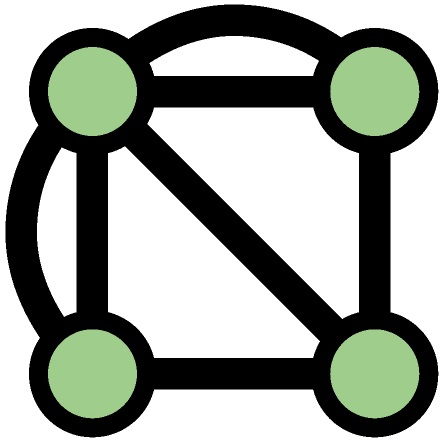In the 18th century, the Prussian city of Königsberg was divided into four pockets: two banks of the river that ran through the city, and two islands within the river. Linking these four pockets were seven bridges.
There was a myth in Königsberg that you could walk through the city by crossing every bridge once and only once. No one had ever succeeded in doing it. Determined to get to the bottom of things, a mathematician named Leonhard Euler decided to apply mathematics to the problem. To get his head around the puzzle of the seven bridges, Euler decided to draw the layout of the city as a simple graph.
His graph consisted of four points or “nodes”— one for each pocket of the city. Connecting those nodes were seven lines— one for each bridge. By doing so, he was able to prove that it was in fact impossible to walk through the city by crossing every bridge once and only once. The seven bridges problem ended up being nothing more than a myth. In trying to solve it, however, Euler created graph theory.
Graph theory drives much of the work in the laboratory of UC Berkeley neuroscientist Mark D’Esposito. One of the main projects in his lab is to use graph theory to address a long-standing debate in neuroscience: whether brain areas are more discrete or integrated— that is, whether different parts of the brain operate independently or whether they act in concert.
Neuroscientists have long known that the brain has specialized areas for processing particular kinds of information, such as a face-processing area and a language-processing area. But these areas aren’t entirely separate: brain areas are constantly chattering with one another and working together to process the stupendous amount of information that flows through them. Neuroscientists think that how the brain manages this discrete-vs-integrated balancing act is likely crucial to its ability to process so much information.
To shed light on this question, D’Esposito and his graduate student Maxwell Bertolero, together with neuroscientist B.T. Thomas Yeo from National University of Singapore, applied graph theory to functional magnetic resonance imaging data collected while human subjects engaged in a range of cognitive tasks.
The first step in their analysis was to find relatively discrete brain modules. To understand what a module is, think about your own social network: people you know are more likely to know each other than they are to know a random person in another country, and members of a network in another country are more likely to know each other than they are to know you. These discrete social networks can be called modules inside of the much bigger network of everyone on Earth.
There are straightforward methods in graph theory for identifying such modules in a network. By treating the brain as a graph— with different brain areas represented by nodes on the graph, and the functional relations between those areas represented by lines connecting those nodes— neuroscientists can identify discrete brain modules.
Bertolero, Yeo, and D’Esposito’s work suggests that the brain really is more discrete than it is integrated: brain modules carry out separate functions and don’t talk much with each other. But that’s not the whole story. There are some cognitive tasks that require different brain modules to work together. But if they’re not talking to each other, then how do they coordinate?
To address this question, Bertolero and D’Esposito divided the nodes within the brain into two types: local nodes and connector nodes. To understand what this means, let’s go back to our example of your social network. You probably have some friends who only talk to other people inside their network, and don’t branch out very often. They are local nodes. You probably also have friends who belong to a given social network, but have a lot of friends all around the world. They are connector nodes.
 Local nodes (blue) only connect to nodes within the same module, whereas connector nodes (yellow) connect to nodes in different modules.
Local nodes (blue) only connect to nodes within the same module, whereas connector nodes (yellow) connect to nodes in different modules.
Bertolero, Yeo, and D’Esposito found that connector nodes act like bridges across brain modules. When a lot of different brain areas need to work together, local nodes don’t change much. They’re talking just as loudly (or quietly) as they were when you didn’t need a lot of brain areas acting in concert, and they’re mostly talking amongst themselves. But when you need the cooperation of a lot of brain modules, the connector nodes start ramping up their activity, talking all the more loudly the more interconnected your brain needs to be. Imagine that all of humanity needed to work together to achieve something. If the global social network acted like the brain, then most people would go about business as usual, and wouldn’t change their behavior much. But the people who have a lot of friends around the world would go into overdrive, working hard to make sure that information gets passed between different groups.
Although these findings suggest that the brain is more discrete than it is integrated, and that brain areas cooperate through the activity of connector nodes, neuroscientists still have much to learn about the purpose of being more discrete or integrated. Though scientists don’t yet have an answer to this question, the functional importance of the discrete-vs-modular tradeoff is currently the subject of research in dozens of neuroscience labs around the world. What we do know is that getting to the bottom of this discrete-vs-integrated balancing act is likely to shed light on a wide range of phenomena, from memory to addiction to the nature of consciousness.
This article is part of the Spring 2016 issue.




